
J. Ross Baughman
[Editor’s Note: On the eve of the 70th anniversary of the June 6, 1944 Allied invasion of Normandy (commonly referred to as D-Day), photojournalist J. Ross Baughman emailed me the following thoughts on Robert Capa’s iconic “Magnificent Eleven” exposures of the event. Speaking from his perspective as an experienced front-line photojournalist, Baughman raises significant questions about the legends that have come to surround these images, both Capa’s production of them and their subsequent fate. In this first of a two-part series, he weighs the published accounts and visual evidence of Capa’s brief involvement in the landing. — A. D. C.]
•
Robert Capa’s Troubles on Omaha Beach (1)
A careful examination of the D-Day negatives tells a very different story.
by J. Ross Baughman
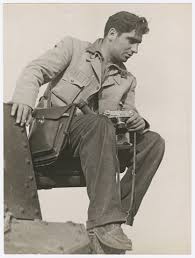
Robert Capa holding his 35mm Contax on a Japanese tank captured at the Battle of Taierzhuang, Xuzhou Front, China, April 1938. Photographer unknown.
Volunteers who jump out of a perfectly good airplane into a war zone have already proven their courage. Either that or else our heroes have an extremely naïve view of war as a romantic adventure. What if such a person later accepts — even volunteers — to be in the first assault wave to land at Omaha Beach on D-Day? That must prove his strength of character beyond all doubt.
He not only hits the beaches of Normandy on one of the bloodiest days for America in World War II, but to paraphrase the actress Ginger Rogers, he does it running backwards, standing tall and turning his back to the enemy machine-gunners raking the beach.
The problem? Robert Capa felt smothered by his reputation as a fearless, heroic war photographer, and he did not want to be facing Hitler’s Fortress Europe on the coast of France.
•
Part of our problem understanding what Capa experienced is the mythology that has grown up around him.

Alfred Hitchcock, “Rear Window” (1954), poster.
And part of that confusion can trace to Hollywood. During his own lifetime, Capa makes a big impression on stars like Ingrid Bergman, one of his many lovers, and directors like Alfred Hitchcock, who bases his 1954 movie Rear Window on Capa’s notorious affairs. Even the future First Lady, Jacqueline Bouvier Kennedy, has a life-long crush on Capa. [Editor’s note: Hitchcock had observed Ingrid Bergman’s romance with Capa while shooting Notorious with Bergman in 1946. Rear Window follows closely Cornell Woolrich’s 1942 short story “It Had to Be Murder,” whose LIFE war-photographer protagonist is played by Jimmy Stewart.]
The filmmaker Steven Spielberg keeps Capa’s pictures in mind and hand as he frames the early battle scenes of Saving Private Ryan. “I did everything I could to get June 6, 1944 to look like Bob Capa’s photographs,” says the director. In one particularly unforgettable moment, the first landing boat chugs up to the water’s edge, drops down its metal front door, and is immediately turned into a long coffin filled with G.I.’s who hadn’t even taken their rifles out of their plastic bags. German gunners shoot bursts at the front of each boat and their bullets rip through row after row of waiting Americans.
Some of the veterans consulted by Spielberg feed him such details. Unfortunately, the trope of one bullet shooting through several people lined up in a row is a favorite device for Spielberg, having appeared with little variation in at least three of his films.
Some of these D-Day invaders manage to crawl out of the line of fire and dump themselves over the sides of the landing craft. Their heavy gear only drags them into a drowning death.
Is this what Capa experienced?
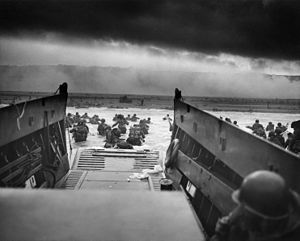
“Into the Jaws of Death,” photo by Chief Photographer’s Mate Robert F. Sargent. Assault craft land one of the first waves at Omaha Beach, Company E, 16th Infantry, 1st Infantry Division. Courtesy National Archives and Records Administration.
Some of the same scenes, from very similar vantage points, have been preserved on 16mm black & white newsreel footage. They show time enough for the troops to exit their boats in a well-drilled, orderly way.
We can see from Capa’s camera that he is standing a few feet back from the broad hatch door. The deck beneath his feet seems empty of any instant casualties or even signs of abandoned gear. Capa is apparently the last occupant of the boat, because we can see all of the others who left ahead of him are now a dozen yards into the surf.
Capa takes at least six different photos from this angle, being somewhat high above and behind the troops. Because of this prolonged pause, the boatswain feels compelled to put a boot to Capa’s backside, forcing him into the water. Was the driver perhaps over-eager to shorten his own time sitting on the beach? Did he even recognize what Capa was doing? Or was Capa having second thoughts?
•
“Capa had a reputation as a great war photographer … and he was stuck with it,” says John G. Morris, the photo editor at LIFE magazine’s offices in London. Morris implies that Capa felt more than just excitement about D-Day, in fact a deep dread about his chances on Omaha Beach, a trap of his own making.
Part of the confusion traces to Capa’s own carefully crafted, devil-may-care persona. He raises the idea of war being romantic — meaning even those moments when bullets are whizzing nearby — during a radio interview in 1947. Jinx Falkenburg, his slightly stunned interviewer, can’t seem to understand what he means.
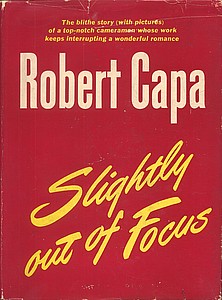
Robert Capa, “Slightly Out of Focus” (1947), cover.
“I was the most elegant invader of them all,” he confides in the memoir Slightly Out of Focus, the book he is promoting during the radio interview. The helmet he wears during the Italian Campaign bears the inscription “Property of Robert Capa, great war correspondent and lover.”
Capa also chooses a very fashionable Burberry raincoat for the invasion and a silver drinking flask from Dunhill. He also brings a supply of condoms, the same kind issued to every G.I.
Now struggling in the water, Capa might wish he’d left behind the Rollei and Speed Graphic cameras, along with a telephoto lens and a flash kit, all packed in oilskin bags, and even an inflatable raft to carry it ashore. He relies primarily on two Contax 35mm cameras, and from an inspection of his negatives, Capa experienced a tell-tale problem while loading film into one of these. Sprocket holes overlapped the bottom edge of all his pictures.
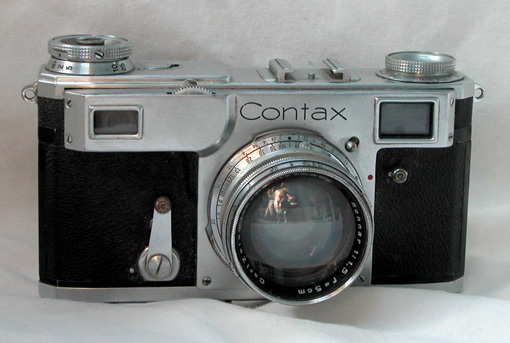
Contax II 35mm rangefinder camera with Carl Zeiss Jena 5 cm f/1.5 high-speed lens.
In the distance of one Capa picture on Omaha Beach, dozens of American troops are huddled together, and sheltering against enemy machine gun fire behind a half-destroyed amphibious tank. It looks like the only safe place to be, and this is where Capa spends the next hour or so. The armored hulk is high enough and sitting at such an angle as to easily allow men to stand behind it.
One reason his pictures from Omaha Beach prove to be slightly out of focus? In the dawn’s early light, Capa’s camera can give him no more than a modest shutter speed and a shallow depth of field. Add that to his trembling hand and “a new kind of fear shaking my body from toe to hair, and twisting my face.”
•
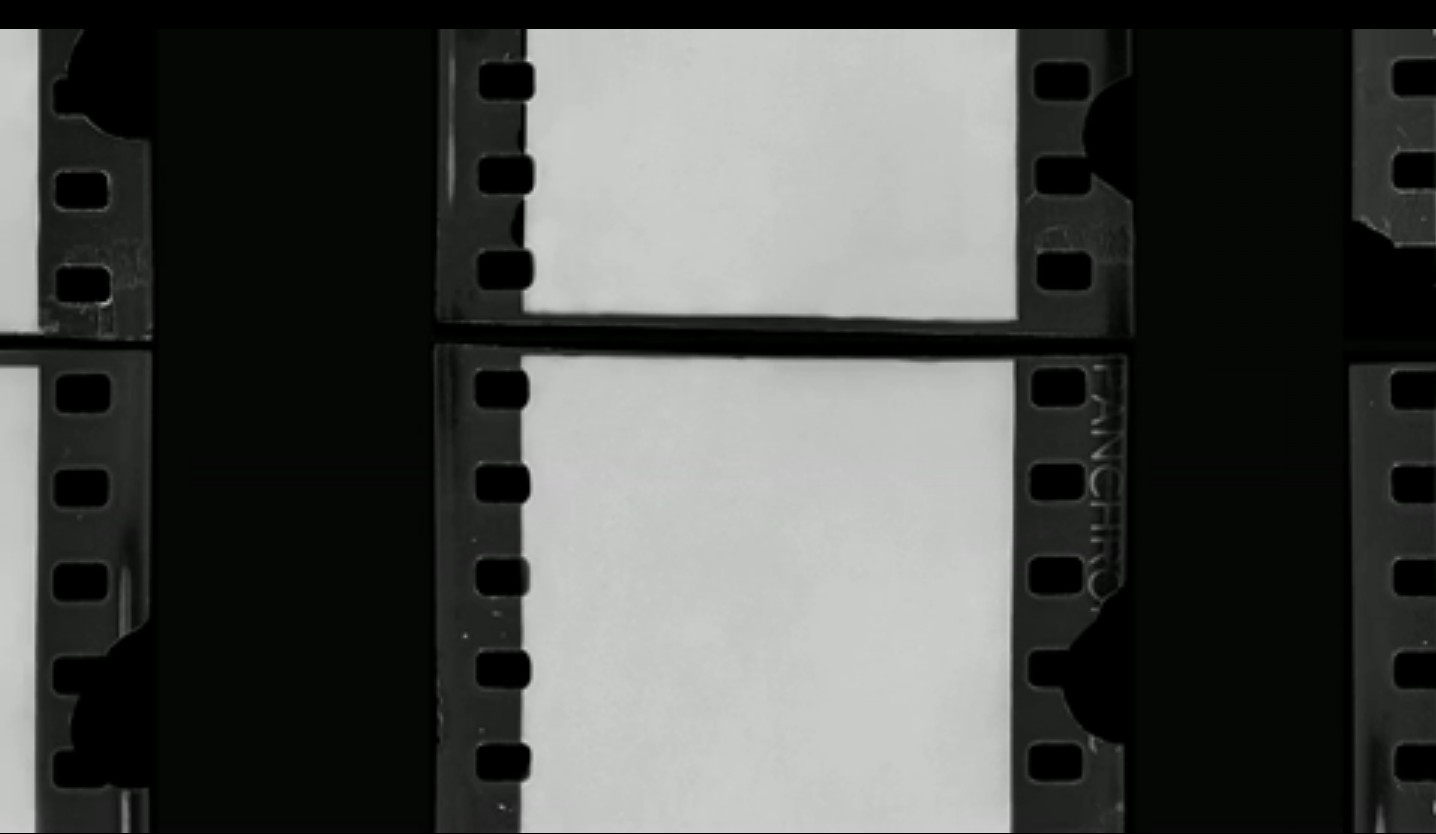
* Robert Capa, spoiled frames from D-Day, June 6, 1944. Courtesy Wikimedia Commons.
One G.I. named Huston Riley takes thirty minutes to wade ashore, and just as he reaches solid ground is hit by gunfire, falling wounded into the surf a few feet short of the broken amphibious tank. According to Riley, two men expose themselves to enemy fire and help Riley reach cover, one of whom has a camera around his neck. The photographer is Capa, and somewhere between the moment when Riley reaches the surf and when he is being lifted out of the water, Capa manages to both save a life and get the picture. His hands are shaking. Shortly thereafter, his camera jams.
But now, how to dispatch the film safely back to LIFE‘s home office in London?
•
With the combined efforts of John Morris of Time-Life and the War Department, there is a plan in place for how Capa and the rest of the press photographers should caption and prepare their rolls of film for the return trip. Army officers would be collecting envelopes and hand-carrying them.
Capa’s hurried note explains how “Film, like everything, got wet. …”
Robert Landry, LIFE‘s photographer at Utah Beach, gives all his film to an American colonel heading back to England, but the packet, including the work of several cinematographers, accidentally falls into the English Channel.
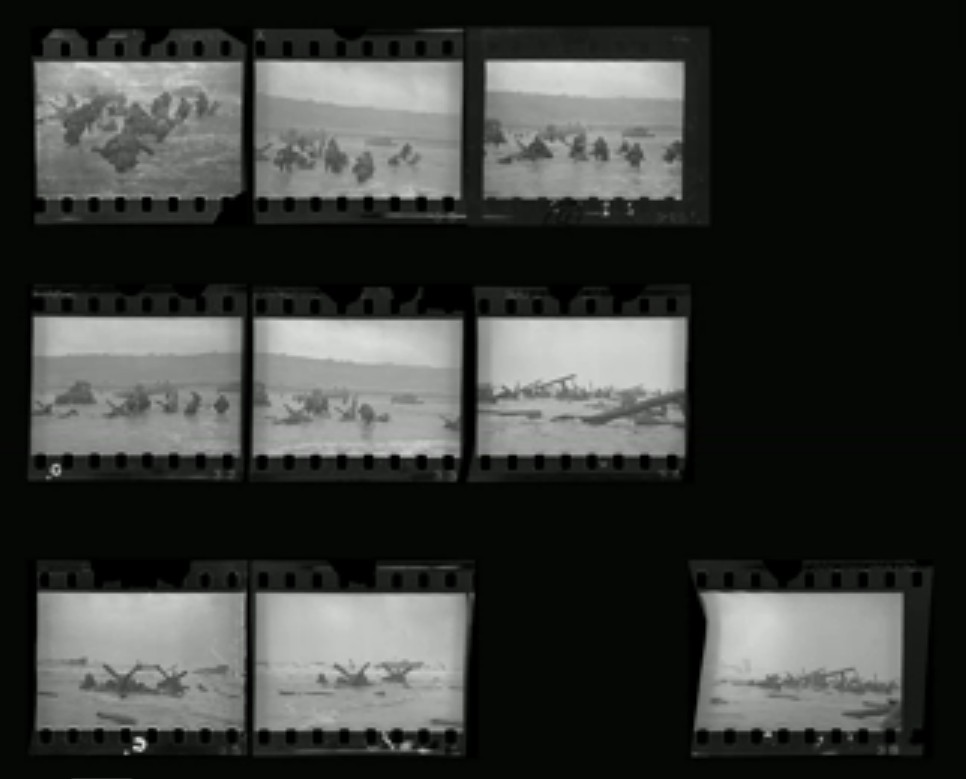
Robert Capa, D-Day frames from 6 June 1944. Courtesy Wikimedia Commons.
One of the strongest impulses felt by any war photographer is the chase for that elusive, all-powerful image, the one that is waiting just around the next corner. At that moment, however, Capa realizes he has had enough.
“I held my camera over my head. … I stepped into the sea between two bodies … and suddenly I knew I was running away,” Capa writes. He is no longer looking for a courier. He remains unscratched, but he is quitting the battlefield.
What could be more difficult to admit to oneself, to his fellow photographers, to his buddy Ernest Hemingway, let alone the soldiers all around him, and the expectations of LIFE‘s editors and readers?
Capa reaches a medical evacuation boat, narrowly missing several explosions and many of the 1,400 Americans who died on that one long day. On the ship returning to Weymouth, he puts a fresh roll of film in the Rolleiflex for one last shot. He composes a view of wounded troops on deck, and shortly thereafter passes out. When his senses return, he is naked, flat out in a bunk, a piece of paper attached to a string around his neck: “Exhaustion case. No dog tags.”
•
(Click here for Part 2. For an index of links to all posts in this series, click here.)
(To see all of Capa’s D-Day images at the Magnum website, click here.)
[Editor’s note: Subsequent research by Rob McElroy revealed that all supposed examples of Capa’s “damaged” D-Day negatives published in the May 29, 2014 TIME video, such as the one above (*), were forgeries produced by Magnum in collusion with the International Center of Photography. — A. D. C.]
•

J. Ross Baughman
In 1978, at the age of 23, photojournalist J. Ross Baughman became the youngest professional ever awarded the Pulitzer Prize, and was cited for his coverage of the guerrilla war in southern Africa. While continuing to work that same year as the first contract photojournalist ever hired by the Associated Press, he competed against himself with two other nominations: For infiltrating the American Nazi movement over nine months to uncover their assassination and bombing plans and once more for being the first journalist to ever accompany Palestinian commandos operating behind Israeli lines.
Baughman soon went on to become an international lecturer on journalism ethics, a university professor and founder of the photo agency Visions, which specialized in long-term, high-risk, difficult-access investigative photo essays around the world. Besides covering wars in 11 countries, his work has appeared everywhere from LIFE to Vanity Fair, Newsweek, Time, Stern, The New York Times Magazine and Vogue.
Some of his writings and photographs may be seen at Wikipedia and at his own website. For his previous Guest Post, click here. To contact J. Ross Baughman, click here.






Have just begun working through this series. Congratulations. I have long questioned many of the supposed details of Capa’s D-Day feats and am glad to see many of those suspicions shared by others.
As to the Spielberg version of the landings, it is a version that stems from the narrow sector in front of Exit D-1, where a ‘perfect storm’ of bad luck and bad planning resulted in a very bad situation. Omaha Beach, however, was more than 6.4 miles long, and the events in front of D-1 — though not typical of the landing — have become representative in the public’s mind, mostly due to bad movie making. For instance, many of the losses before D-1 were due to using British LC(A) landing craft (rather than US LCVPs) which had a very narrow exit ramp, permitting only one man at a time to exit. Further, the partial overhead covering of the troop space in the LC(A) made it almost impossible to exit over the side. This, combined with the specific concentration of German defenses at D-1 did make many landing craft exits death funnels. But that was the ONE point on that long beach with that extremely adverse combination of conditions. It most certainly was NOT the case where Capa landed — as you correctly point out.
Just a note about casualties, the US V Corps, which made the Omaha landings, reported ‘only’ 1225 US KIA in the week beginning on 6 June — over half of which were suffered on 6 June itself. As the V Corps during this week of fighting included the 1st, 2d and 29th Infantry divisions, the 2d Armored Division and the division-sized Engineer Special Brigade Group, as well as scores of thousands of support troops, the bloodbath of Omaha — as bad as it was — was not nearly as bad as popular myth would have one believe. (I say this as an infantry combat vet who understands loss of friends.) By comparison, the 2d Marine Division — a single division — at Tarawa lost about 1700 KIA in four days. Yes, that one division lost a third more men in 4 days than an entire Army corps lost on and beyond Omaha Beach in a week. The point being, the popular image of the Omaha bloodbath may have many grains of truth to it, but has been vastly twisted and exaggerated by time and media. In fact, given the scope of WWII carnage (405,000 US dead alone) and considering the efforts the German Army put into fortifying the coast, the losses on Omaha were fairly moderate — as long as you weren’t one of them.
Again, thanks for your series.
Speaking for myself and Ross Baughman as well, we appreciate your detailed commentary, especially given that it’s grounded in infantry combat experience. We’ll welcome any further input as you make your way through the series — still underway, I should add, with more to come.
Charles Herrick, Thanks for the time and detail you’ve put into this comment. I hope more and more people will help to correct the mythology that surrounds Omaha Beach.